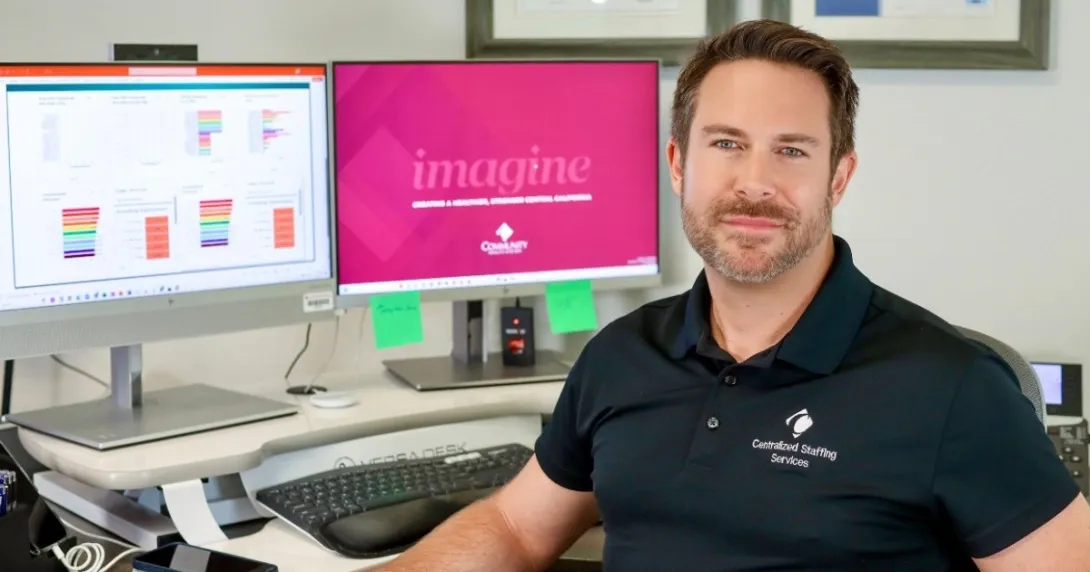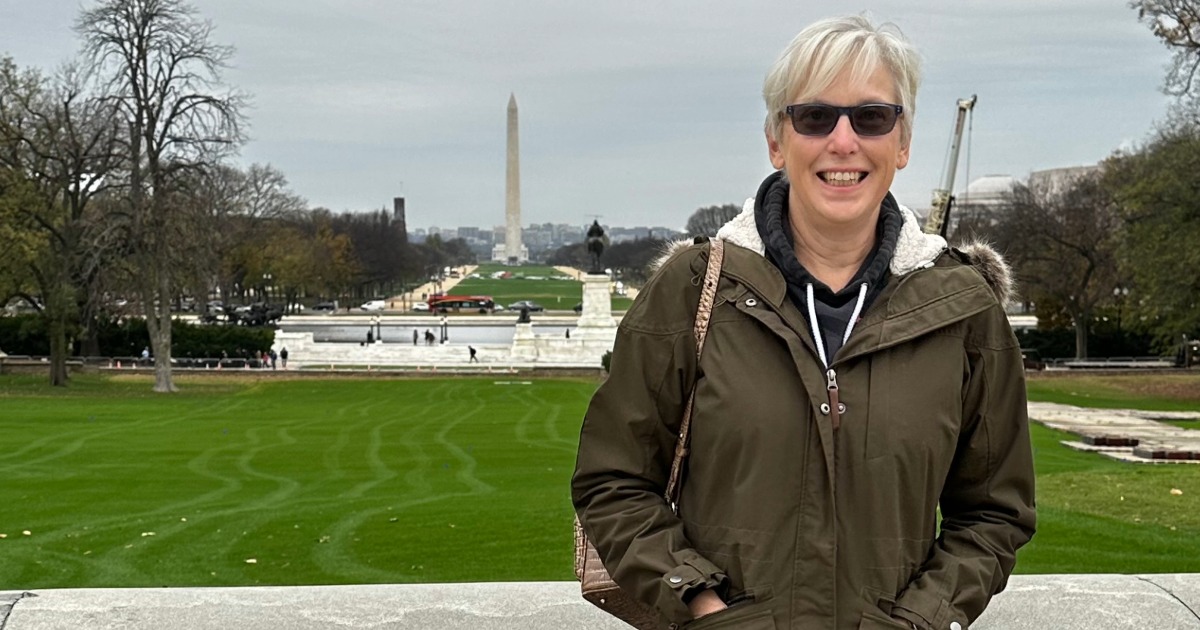
Jon Stabbe, director of workforce management at Community Health System
Photo: Community Health System
Community Health System is a healthcare organization in central California that faced significant challenges with workforce scheduling and visibility.
THE CHALLENGE
With more than 11,000 employees – including 5,000 registered nurses and thousands of patient technicians – the health system's scheduling processes were fragmented and inconsistent across departments. Many units relied on manual methods like spreadsheets, paper logs and even Post-it notes on walls to manage shifts.
These outdated practices led to frequent errors, lack of real-time visibility and inefficiencies in workforce utilization. It was common to find discrepancies between what was posted manually and what was reflected in systems, which created confusion about who was actually scheduled to work.
The pandemic further exposed these vulnerabilities. Leaders needed immediate insight into staffing levels, especially to track symptomatic callouts and ensure coverage. Without a centralized system, Community Health struggled to respond quickly and accurately.
Managers were spending excessive time manually approving shift swaps and updating schedules, which not only drained their time but also delayed critical staffing decisions. Leaders also discovered widespread FTE leakage – employees were not being scheduled to their full capacity, and gaps in coverage were often filled with costly contract labor.
These issues impacted not only operational efficiency but also employee satisfaction and patient care.
"Ultimately, the lack of a unified, automated scheduling system kept us from leveraging our workforce effectively," said Jon Stabbe, director of workforce management at Community Health System. "It created downstream problems in payroll, reporting and staffing dashboards – and made it difficult to maintain compliance and consistency.
"We knew we needed a reset – one that would allow us to fully use the technology we already had access to and bring our scheduling practices into alignment across the organization," he continued.
Further, costs rose for overtime, incentivized shifts, employee burnout, shift offering fatigue (employees receiving constant messages for shift pick-up), and manager time away from support to their employees, he added.
PROPOSAL
IT vendor UKG proposed to Community Health to centralize and streamline scheduling processes across the health system.
"The idea was to move away from our fragmented, manual scheduling methods – like spreadsheets, paper logs and ad hoc shift swaps – and instead adopt a unified digital platform that could automate and optimize workforce management," Stabbe explained. "The technology promised to give us real-time visibility into staffing levels, reduce administrative burden on managers, and empower employees with more control over their schedules.
"This included deploying both basic and advanced scheduling tools tailored to the needs of different departments," he continued. "For example, procedural areas like surgery and pharmacy, which had unique scheduling requirements, would be supported by a system like UKG EZCall. Meanwhile, clinical units would benefit from features like shift swaps and open shifts, allowing employees to pick up available shifts or trade with colleagues without manager intervention."
This would not only save time but also improve accuracy and reduce scheduling gaps, he added.
"And the technology was designed to integrate with our existing systems and dashboards, ensuring that schedule data flowed seamlessly into other operational tools," he said. "This integration would allow us to monitor key metrics – such as missed meals, overtime and FTE utilization – and take proactive steps to address issues before they impacted patient care or employee satisfaction.
"The overarching goal was to create one source of truth for scheduling, eliminate inefficiencies, and build a foundation for smarter, data-driven staffing decisions," he added.
MEETING THE CHALLENGE
To meet staffing challenges, Community Health implemented UKG Pro Workforce Management across the organization. It started by assessing usage and discovered that only about 30% of departments were actively using the new scheduling tools.
"That meant 70% were still relying on manual processes like spreadsheets or paper logs," Stabbe noted. "We launched a system-wide initiative to onboard those departments into either basic scheduling, advanced scheduling or EZCall, depending on their operational needs.
"Our clinical leaders and frontline employees are the primary users of the technology," he continued. "Managers were trained to build and manage schedules directly in the system, while employees were empowered to view their schedules, swap shifts and pick up open shifts using the system's mobile app."
This shift gave employees more control over their work-life balance and reduced the administrative burden on managers. For example, instead of manually approving shift swaps, managers could rely on the technology's automated shift swap feature, which allowed qualified employees to make changes independently.
"We also integrated UKG with Andgo, a staffing automation tool, to streamline callout tracking and shift fulfillment," Stabbe explained. "Initially, Andgo was used to manage last-minute absences, but we expanded its use to proactively fill open shifts up to six weeks in advance.
"When a gap appeared in the schedule – due to a leave of absence, orientation or vacancy – Andgo would blast out shift availability to qualified employees, helping us fill those slots quickly and efficiently," he continued.
UKG was also integrated with internal dashboards and reporting tools. Staff built custom tiles on the UKG homepage that gave managers real-time visibility into key metrics like missed meals, overtime, FTE utilization, and timecard exceptions and approvals.
"This allowed leaders to make on-the-spot decisions, such as relieving staff for breaks or adjusting staffing levels to avoid burnout," he said. "The seamless integration between UKG scheduling, Andgo and our reporting infrastructure created a unified ecosystem that improved accuracy, efficiency and employee satisfaction across the board."
RESULTS
Community Health has seen several measurable outcomes since implementing the UKG technology and the results have been transformative, Stabbe said.
"One of the most impactful results was a $2.8 million reduction in labor costs," he reported. "This came from addressing missed meal breaks, overtime, underutilized full-time employees and agency staff usage. By giving managers visibility into real-time staffing metrics – like who was working past their 12th hour or who hadn't taken a meal break – we empowered them to make immediate adjustments.
"We also reduced our reliance on contract labor by about 50%, simply by identifying and filling gaps with our existing workforce," he continued. "These changes not only saved money but also improved employee satisfaction and retention."
And then there is improved scheduling accuracy and efficiency.
"Before implementing the technology, many departments relied on manual scheduling methods, which led to inaccuracies and inefficiencies," he said. "By transitioning to digital scheduling tools, we eliminated paper-based processes and ensured that schedules were accurately reflected across systems.
"This improved downstream reporting and gave us confidence in our staffing data," he added. "Employees could now view and manage their schedules via mobile apps, swap shifts independently and pick up open shifts across facilities. This flexibility helped us fill gaps faster and gave staff more control over their work-life balance."
Additionally, this gave time back to managers to focus on their departments and caring for their employees and patients, he noted.
Further, Community Health now has record-low job vacancy rates.
"Since implementing the scheduling tools and promoting those in our job postings, we've reached an all-time low in open job positions," Stabbe said. "The ability to offer flexible scheduling and mobile access to shift management has become a competitive differentiator in attracting and retaining talent.
"Employees appreciate the autonomy and transparency, and we've seen a direct correlation between technology adoption and improved retention," he continued. "Additionally, offering our employees the ability to schedule proactively has given them better work-life balance to plan work around their lives."
ADVICE FOR OTHERS
For healthcare organizations considering staffing technology, Stabbe advised to start by embracing the mindset that scheduling is not just an operational task – it's a strategic lever for workforce engagement, retention and patient care.
"The right technology can transform how you manage your workforce, but it requires a commitment to change management and training," he said. "You need to invest in educating both leaders and frontline staff on how to use the tools effectively. We found that some employees were very tech-savvy, while others needed more support. Tailoring training to meet people where they are is essential to driving adoption and maximizing impact.
"It's also critical to ensure the technology integrates well with your existing systems and provides real-time visibility into staffing metrics," he continued. "We built custom dashboards that gave our managers actionable insights – like who missed a meal break or who was working overtime – and that visibility empowered them to make better decisions on the spot."
When teams are given the data they need in a format they can act on, a health system not only improves efficiency but also fosters a culture of accountability and care, he added.
"Ultimately, the technology should serve your people, not the other way around," he concluded. "If it helps them feel more in control of their schedules and more supported in their roles, you'll see the benefits ripple across your organization – from lower turnover to better patient outcomes."
Follow Bill's health IT coverage on LinkedIn: Bill Siwicki
Email him: bsiwicki@himss.org
Healthcare IT News is a HIMSS Media publication.
WATCH NOW: Wisdom on nurses and IT from a health system's nurse CIO


